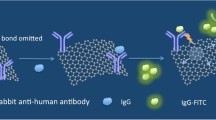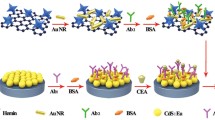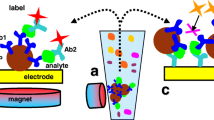Abstract
We propose a homogenous multi-analyte immunoassay based on the quenching of quantum dot (QD) fluorescence by means of graphene. Two QDs with emission maxima at 636 and 607 nm were bound to antibodies selective for mouse or chicken immunoglobulins, respectively, and graphene functionalized with carboxylic moieties was employed to covalently link the respective antigen. The antibody-antigen interaction led graphene close enough to QDs to quench the QD fluorescence by resonance energy transfer. The addition of free antigens that competed with those linked to graphene acted as a “turn-on” effect on QD fluorescence. Fluorescence emitted by the two QDs could be recorded simultaneously since the QDs emitted light at different wavelengths while being excited at the same wavelength and proved to be linearly correlated with free antigen concentration. The developed assay allows measuring both antigens over 2–3 orders of magnitude and showed estimated limits of detection in the nanomolar range. This approach is thus a promising universal strategy to develop homogenous immunoassays for diverse antigens (cells, proteins, low-molecular-mass analytes) in a multi-analyte configuration.







Similar content being viewed by others
References
Durán GM, Contento AM, Ríos Á (2013) Use of Cdse/ZnS quantum dots for sensitive detection and quantification of paraquat in water samples. Anal Chim Acta 801:84–90
Chen L, Zhang X, Zhou G, Xiang X, Ji X, Zheng Z, He Z, Wang H (2012) Simultaneous determination of human enterovirus 71 and coxsackievirus B3 by dual-color quantum dots and homogeneous immunoassay. Anal Chem 84:3200–07
Kamat PV (2013) Quantum dot solar cells. The next big thing in photovoltaics. Phys Chem Lett 4(6):908–918
Bae WK, Kwak J, Lim J, Lee D, Nam MK, Char K, Lee C, Lee S (2010) Multicolored light-emitting diodes based on all-quantum-dot multilayer films using layer-by-layer assembly method. Nano Lett 10(7):2368–73
Liu M, Zhao H, Quian X, Chen S, Fan X (2010) Distance-independent quenching of quantum dots by nanoscale-graphene in self-assembled sandwich immunoassay. Chem Commun 46:7909–11
Dong H et al (2010) Fluorescence resonance energy transfer between quantum dots and graphene oxide for sensing biomolecules. Anal Chem 82:5511–5517
Wang LL et al (2011) Graphene and graphene oxide: biofunctionalization and applications in biotechnology. Trends Biotechnol 5:205–212
Algar WR, Krull UJ (2008) Quantum dots as donors in fluorescence resonance energy transfer for the bioanalysis of nucleic acids, proteins, and other biological molecules. Anal Bioanal Chem 391(5):1609–18
Medintz IL, Mattoussi H (2009) Quantum dot-based resonance energy transfer and its growing application in biology. Phys Chem Chem Phys 11(1):17–45
Zekavati R, Safi S, Hashemi SJ, Rahmani-Cherati T, Tabatabaei M, Mohsenifar A, Bayat M (2013) Highly sensitive FRET-based fluorescence immunoassay for aflatoxin B1 using cadmium telluride quantum dots. Microchim Acta 180(13–14):1217–23
Kim J, Kwon S, Park JK, Park I (2014) Quantum dot-based immunoassay enhanced by high-density vertical ZnO nanowire array. Biosens Bioelectron 55:209–15
He Y, Tian J, Hu K, Zhang J, Chen S, Jiang Y, Zhao Y, Zhao S (2013) An ultrasensitive quantum dots fluorescent polarization immunoassay based on the antibody modified Au nanoparticles amplifying for the detection of adenosine triphosphate. Anal Chim Acta 802:67–73
Beloglazova N, Speranskaya E, De Saeger S et al (2012) Quantum dot based rapid tests for zearalenone detection. Anal Bioanal Chem 403:3013–24
Yu W, Kim IS, Niessner R, Knopp D (2012) Multiplex competitive microbead-based flow cytometric immunoassay using quantum dot fluorescent labels. Anal Chim Acta 750:191–8
Zeng Q, Zhang Y, Liu X, Tu L, Kong X, Zhang H (2012) Multiple homogeneous immunoassays based on a quantum dots-gold nanorods FRET nanoplatform. Chem Commun 48(12):1781–3
Zhao H, Chang Y, Liu M, Gao S, Yu H, Quan X (2013) A universal immunosensing strategy based on regulation of the interaction between graphene and graphene quantum dots. Chem Commun 49:234–36
Sordello F, Zeb G, Hu K, Calza P, Minero C, Szkopek T, Cerruti M, Tuning TiO2 nanoparticle morphology in graphene–TiO2 hybrids by graphene surface modification, Nanoscale, DOI: 10.1039/C4NR01322K
Zeb G, Gaskell P, Le XT, Xiao X, Szkopek T, Cerruti M (2012) Decoration of graphitic surfaces with Sn nanoparticles through surface functionalization using diazonium chemistry. Langmuir 28:13042–50
Peng C, Xiong Y, Liu Z, Zhang F, Ou E, Qian J, Xiong Y, Xu W (2013) Bulk functionalization of graphene using diazonium compounds and amide reaction. Appl Surf Sci 280:914–919
Lee SW, Kim BS, Chen S, Shao-Horn Y, Hammond PT (2008) Layer-by-layer assembly of All carbon nanotube ultrathin films for electrochemical applications. Am Chem Soc 131(2):671–679
Lyskawa J, Bélanger D (2006) Direct modification of a gold electrode with aminophenyl groups by electrochemical reduction of in situ generated aminophenyl monodiazonium cations. Chem Mater 18(20):4755–4763
Pinson J, Podvorica F (2005) Attachment of organic layers to conductive or semiconductive surfaces by reduction of diazonium salts. Chem Soc Rev 34(5):429–439
Mahouche-Chergui S, Gam-Derouich S, Mangeney C, Chehimi MM (2011) Aryl diazonium salts: a new class of coupling agents for bonding polymers, biomacromolecules and nanoparticles to surfaces. Chem Soc Rev 40(7):4143–66
Jasieniak J, Bullen C, van Embden J, Mulvaney P (2005) Phosphine-free synthesis of CdSe nanocrystals. J Phys Chem B 109(44):20665–68
Capek RK, Moreels I, Lambert K, De Muynck D, Zhao Q, Van Tomme A, Vanhaecke F, Hens Z (2010) Optical properties of zincblende cadmium selenide quantum dots. J Phys Chem C 114(14):6371–76
Beloglazova NV, Shmelin PS, Speranskaya ES, Lucas B, Helmbrecht C, Knopp D, Niessner R, De Saeger S, Goryacheva IY (2013) Quantum dot loaded liposomes as fluorescent labels for immunoassay. Anal Chem 85:7197–7204
Yu WW, Qu L, Guo W, Peng X (2003) Experimental determination of the extinction coefficient of CdTe, CdSe, and CdS nanocrystals. Chem Mater 15:2854–60
Reiss P, Protière M, Liang L (2009) Core/shell semiconductor nanocrystals. Small 5(2):154–168
Li JJ, Wang YA, Guo WZ, Keay JC, Mishima TD, Johnson MB, Peng XG (2003) Large-scale synthesis of nearly monodisperse CdSe/CdS core/shell nanocrystals using air-stable reagents via successive Ion layer adsorption and reaction. J Am Chem Soc 125:12567–75
Grabolle M, Spieles M, Lesnyak V, Gaponik N, Eychmuller A, Resch-Genger U (2009) Determination of the fluorescence quantum yield of quantum dots: suitable procedures and achievable uncertainties. Anal Chem 81:6285–6294
Eftink MR (2000) Intrinsic fluorescence of proteins topics in fluorescence spectroscopy. Top Fluoresc Spectrosc 6:1–15
Acknowledgments
We acknowledge the support from a Marie Curie International Research Staff Exchange Scheme Fellowship (PHOTOMAT, proposal no. 318899) within the 7th European Community Framework Programme, and from the Canada Research Chair foundation.
Author information
Authors and Affiliations
Corresponding author
Rights and permissions
About this article
Cite this article
Anfossi, L., Calza, P., Sordello, F. et al. Multi-analyte homogenous immunoassay based on quenching of quantum dots by functionalized graphene. Anal Bioanal Chem 406, 4841–4849 (2014). https://doi.org/10.1007/s00216-014-7885-6
Received:
Revised:
Accepted:
Published:
Issue Date:
DOI: https://doi.org/10.1007/s00216-014-7885-6




